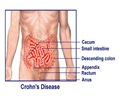Growing up with dogs (but not cats) and a large family may help lower the risk of inflammatory bowel disease and Crohn’s disease as per a study.

‘Growing up with dogs (but not cats) and a large family may help lower the risk of inflammatory bowel diseases like Crohn’s disease and inflammatory bowel disease, respectively.’





People with Crohn’s disease who were enrolled in the Crohn’s and Colitis Canada Genetic, Environmental, and Microbial (CCC-GEM) project were included in the study analysis of several environmental factors, including family size, the presence of dogs or cats as household pets, the number of bathrooms in the house, living on a farm, drinking unpasteurized milk and drinking well water.
Dogs and Bowel Diseases — The Link
“Our study seems to add to others that have explored the ‘hygiene hypothesis’ which suggests that the lack of exposure to microbes early in life may lead to lack of immune regulation toward environmental microbes,” says Dr. Williams Turpin at the Mount Sinai Hospital and the University of Toronto.It was found that exposure to dogs, particularly from ages 5 to 15, was linked with healthy gut permeability and balance between the microbes in the gut and the body’s immune response. This may help one from acquiring Crohn’s disease.
“We did not see the same results with cats, though we are still trying to determine why. It could potentially be because dog owners get outside more often with their pets or live in areas with more green space, which has been shown previously to protect against Crohn’s,” says Dr. Turpin.
The study also found another protective factor — living with three or more family members in the first year of life.
Source-Medindia









